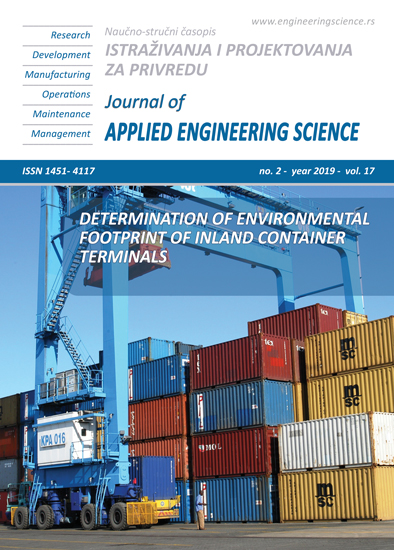PARAMETER FOR SCALE-UP OF EXTRACTION CYMBOPOGON NARDUS DRY LEAF USING MICROWAVE ASSISTED HYDRO-DISTILLATION
Abstract
Large capacity in extraction using the microwave hydrodistillation method is always a challenge to do. The biggest obstacle in this method is the limitations of microwaves penetrating the material. Besides that, the high heat produced due to molecular heating simultaneously causes some components to degrade and reduce the quality of essential oils. Research on the effect of load capacity on yields of Cymbopogon nardus using microwave equipment was carried out. This research compared the effect of different parameters time ekstraction and ratio feed to solvent (F/S). In the study also carried out a volume distiller comparison with microwave cavity volume (D/M). These research was performed microwave power irradiation at 100%, 80%, and 60% together feed to solvent ratio (F/S) 8%, 16% and 24% at ratio (D/M) of 0,04. Analysis of oil composition using GC MS was carried out to show that the length of extraction time did not provide an effect on changes in the composition of the oil extracted. The results of these experiments indicate that usage of 80% of microwave power irradiation and 16% ratio of feed to volume distiller together with 24% of feed to solvent ratio, effective to increase oil yields by up to 1,2. The same yield was obtained by increasing D/M ratio by increasing microwave power irradiation. Chemical composition of citronella oil was analyzed using GC MS. These citronella oil was found to contain mainly citronella, geraniol and citronellol, and with comprised percent area 40%, 17% and 16% respectively. Increasing microwave power irradiation does not significantly affect the final composition of extraction. The results show the possibility of increasing capacity using microwave-based extraction equipment. These results also have significant implications for the continuing use of microwaves in extraction applications and could be compromised to scale up capacity.
References
Avoseh, Opeyemi, Opeoluwa Oyedeji, Pamela Rungqu, Benedicta Nkeh-Chungag, and Adebola Oyedeji. 2015. “Cymbopogon Species; Ethnopharmacology, Phytochemistry and the Pharmacological Importance.” Molecules 20 (5):7438–53. https://doi.org/10.3390/molecules20057438.
Brodie, G.I. 2008. “The Influence of Load Geometry on Temperature Distribution during Microwave Heating.” Transactions of the ASABE 51 (4). https://doi.org/10.13031/2013.25224.
Chanthai, Saksit, Sujitra Prachakoll, Chalerm Ruangviriyachai, and Devanand L. Luthria. 2012. “Influence of Extraction Methodologies on the Analysis of Five Major Volatile Aromatic Compounds of Citronella Grass (Cymbopogon Nardus) and Lemongrass (Cymbopogon Citratus) Grown in Thailand.” Journal of AOAC International 95 (3):763–72. https://doi.org/10.5740/jaoacint.11-335.
Chemat, Farid, and Giancarlo Cravotto. 2013. Microwave-Assisted Extraction for Bioactive Compounds : Theory and Practice. Edited by Farid Chemat and Giancarlo Cravotto. Springer New York Heidelberg Dordrecht London.
Chemat, Farid, Natacha Rombaut, Jean T Pierson, and Antoine Bily. 2015. Green Extraction : From Concepts to Research , Education , And.
Delazar, Abbas, Lutfun Nahar, Sanaz Hamedeyazdan, and Satyajit D Sarker. 2012. “Natural Products Isolation” 864. https://doi.org/10.1007/978-1-61779-624-1.
Desai, Meghal A, and Jigisha Parikh. 2015. “Extraction of Essential Oil from Leaves of Lemongrass Using Microwave Radiation: Optimization, Comparative, Kinetic, and Biological Studies.” ACS Sustainable Chemistry and Engineering 3 (3):421–31. https://doi.org/10.1021/sc500562a.
Eskilsson, Cecilia Sparr, and Erland Björklund. 2000. “Analytical-Scale Microwave-Assisted Extraction.” Journal of Chromatography A 902 (1):227–50. https://doi.org/10.1016/S0021-9673(00)00921-3.
Flórez, Noelia, Enma Conde, and Herminia Domínguez. 2015. “Microwave Assisted Water Extraction of Plant Compounds.” Journal of Chemical Technology and Biotechnology 90 (4):590–607. https://doi.org/10.1002/jctb.4519.
Golmakani, Mohammad Taghi, and Karamatollah Rezaei. 2008. “Comparison of Microwave-Assisted Hydrodistillation Withthe Traditional Hydrodistillation Method in the Extractionof Essential Oils from Thymus Vulgaris L.” Food Chemistry 109 (4):925–30. https://doi.org/10.1016/j.foodchem.2007.12.084.
Hamzah, Muhammad Hazwan, Hasfalina Che Man, Zurina Zainal Abidin, and Hishamuddin Jamaludin. 2014. “Comparison of Citronella Oil Extraction Methods from Cymbopogon Nardus Grass by Ohmic-Heated Hydro-Distillation, Hydro-Distillation, and Steam Distillation.” BioResources 9 (1):256–72. https://doi.org/10.15376/biores.9.1.256-272.
Manvitha, Karkala, and Bhushan Bidya. 2014. “Review on Pharmacological Activity of Cymbopogon Citratus” 1 (6):5–7.
Nitthiyah, Jeyaratnam, Abdurahman Hamid Nour, Ramesh Kantasamy, and John O Akindoyo. 2017. “Microwave Assisted Hydrodistillation – an Overview of Mechanism and Heating Properties.” Australian Journal of Basic and Applied Sciences 11 (3):22–29.
Ormeño, Elena, Allen Goldstein, and Ülo Niinemets. 2011. “Extracting and Trapping Biogenic Volatile Organic Compounds Stored in Plant Species.” TrAC - Trends in Analytical Chemistry 30 (7):978–89. https://doi.org/10.1016/j.trac.2011.04.006.
Petigny, Loïc, Sandrine Périno, Matteo Minuti, Francesco Visinoni, Joël Wajsman, and Farid Chemat. 2014. “Simultaneous Microwave Extraction and Separation of Volatile and Non-Volatile Organic Compounds of Boldo Leaves. from Lab to Industrial Scale.” International Journal of Molecular Sciences 15 (5):7183–98. https://doi.org/10.3390/ijms15057183.
Pozar, D. 2005. Microwave Engineering Fourth Edition. John Wiley & Sons. https://doi.org/TK7876.P69 2011.
Sadgrove, Nicholas, and Graham Jones. 2015. “A Contemporary Introduction to Essential Oils: Chemistry, Bioactivity and Prospects for Australian Agriculture.” Agriculture 5 (1):48–102. https://doi.org/10.3390/agriculture5010048.
Singh, Ashutosh, Gopu Nair, Pansa Liplap, Yvan Gariepy, Valerie Orsat, and Vijaya Raghavan. 2014. “Effect of Dielectric Properties of a Solvent-Water Mixture Used in Microwave-Assisted Extraction of Antioxidants from Potato Peels.” Antioxidants 3 (1):99–113. https://doi.org/10.3390/antiox3010099.
Singh, Avinash, and Ajay Kumar. 2017. “Cultivation of Citronella ( Cymbopogon Winterianus ) and Evaluation of Its Essential Oil , Yield and Chemical Composition in Kannauj Region” 13 (2):139–46.
Sparr Eskilsson, Cecilia, and Erland Björklund. 2000. “Analytical-Scale Microwave-Assisted Extraction.” Journal of Chromatography A. https://doi.org/10.1016/S0021-9673(00)00921-3.
Stefanidis, Georgios D., Alexander Navarrete Muñoz, Guido S.J. Sturm, and Andrzej Stankiewicz. 2014. “A Helicopter View of Microwave Application to Chemical Processes: Reactions, Separations, and Equipment Concepts.” Reviews in Chemical Engineering 30 (3):233–59. https://doi.org/10.1515/revce-2013-0033.
Thakker, Miral R., Jigisha K. Parikh, and Meghal A. Desai. 2016. “Microwave Assisted Extraction of Essential Oil from the Leaves of Palmarosa: Multi-Response Optimization and Predictive Modelling.” Industrial Crops and Products 86:311–19. https://doi.org/10.1016/j.indcrop.2016.03.055.
Toledo, Luciani Gaspar De, Matheus Aparecido Dos Santos Ramos, Larissa Spósito, Elza Maria Castilho, Fernando Rogério Pavan, Érica De Oliveira Lopes, Guilherme Julião Zocolo, et al. 2016. “Essential Oil of Cymbopogon Nardus (L.) Rendle: A Strategy to Combat Fungal Infections Caused by Candida Species.” International Journal of Molecular Sciences 17 (8). https://doi.org/10.3390/ijms17081252.
Zhang, Hua, and General Electric. 2017. “Microwave Heating of Foods,” no. January.
Zhang, Zhijun, Tianyi Su, and Shiwei Zhang. 2018. “Shape Effect on the Temperature Field during Microwave Heating Process.” Journal of Food Quality 2018:1–24.

